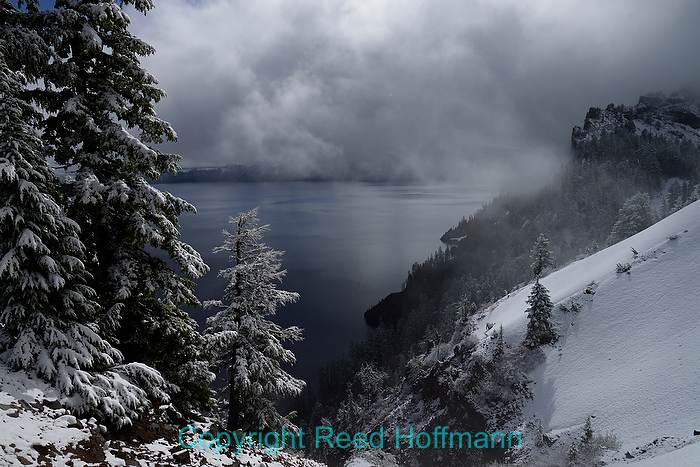I recently wrote about choosing to shoot black and white in Yosemite as a change of pace. One reason that worked so well was because the weather was made for black and white – rainy and heavily overcast. Which brings me to the subject of today’s story – weather. Photographers know that bad weather can produce good pictures. Unfortunately, that same bad weather often discourages us from going out and shooting. It should really be the other way around. When you get bad weather, go out into it. But that’s not our inclination, and it’s not just because it’s uncomfortable.
Scientists have studied what appeals to human vision. We’re drawn to brightness, contrast and saturated colors. All of those things are more prominent when the sun’s out. And they also happen to be some of the most common tweaks we make to our pictures on the computer after we’ve shot them. So it’s natural for us to be less than excited about going out to shoot on cloudy, overcast days. That lack of color and contrast makes it harder to find interesting pictures. Not impossible, of course, but more difficult.
And if the lessened visual impact isn’t enough of a challenge, then it might be raining, snowing or cold too. Let’s admit it – it’s a lot tougher to go outside when the weather’s bad. So why should we? Because there are great pictures to be made.
Rain means water dripping off surfaces, beading off branches, leaves and flowers. It means puddles creating reflections. Wet windows, and fogged glass to shoot through. The resulting lack of contrast means backgrounds can disappear into a fog of gray. And rain doesn’t mean color is entirely gone. There’s a special, lush green you only get in areas that receive lots of rainfall. You guys in the northwest know what I’m talking about.
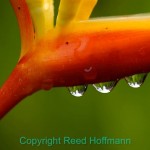
Rainforests are called that for a reason. So you have to work with the water. Nikon D70, ISO 200, 1/200, f/3.8, -0.3 EV, 60mm lens. Photo copyright Reed Hoffmann.
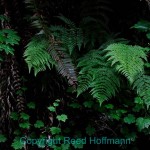
These are the vibrant greens you get in areas of heavy rainfall, like this one on the Oregon coast. Nikon D3X, ISO 250, 1/20, f/4, -2.0 EV, 70-200mm lens. Photo copyright Reed Hoffmann.
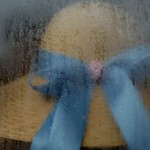
A rainy day made this photo of a shopfront window special. Nikon D50, ISO 200, 1/30, f/3.2, 0.0 EV, 17-55mm lens. Photo copyright Reed Hoffmann.
Cold has its rewards too. There’s a cool blue to dawn and dusk on very cold days. When the temperature drops below freezing, you can start working with patterns created by frost and ice, as well as the beautiful coatings they form on different objects. With snow, the world is transformed into stark patterns of line and soft shapes. A fresh, wet snow will give trees a cloak of white icing.
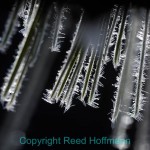
These pine needles were coated in frost after a cold night. Nikon D700, ISO 200, 1/500, f/11, -1.3 EV, 105mm Micro. Photo copyright Reed
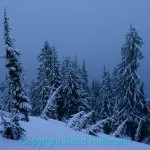
My favorite snow is heavy and wet, clinging to the trees. Nikon D800, ISO 400, 1/125, f/5, -1.0 EV, 16-35mm lens. Photo copyright Reed Hoffmann.
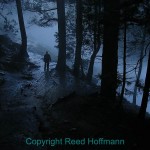
Out on the trail early, the light has a blue cast to it on a cold spring morning. Nikon E3100, ISO 100, 1/58, f/2.8, 0.0 EV, 5.8mm. Photo copyright Reed Hoffmann.
Fog has its own special properties as well, creating layers you can work with. Objects close to you will appear dark against the gray background, while those further away fade into that grayness. This adds a feeling of depth to what would otherwise be a flat, two-dimensional scene. If you’re lucky enough to be in fog when the sun starts burning through, find some trees to shoot through into it, and those shafts of light will be highlighted by the mist.
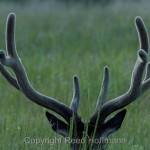
in full sunlight it would be hard to see the delicate nature of the velvet on this elks antlers. Nikon D2X, ISO 200, 1/60, f/8, -0.7 EV, 80-400mm lens. Photo copyright Reed Hoffmann.
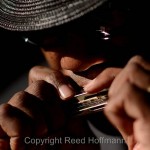
Bright light means hard shadows, which can be graphically interesting, but lack in shadow detail. Nikon D800, ISO 100, 1/4000, f/1.8, -1.7 EV, 85mm lens. Photo copyright Reed Hoffmann.
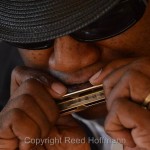
Moving the subject into the shade let me capture much more detail. Nikon D3200, ISO 100, 1/30, f/4, -1.7 EV, 40-120mm lens. Photo copyright Reed Hoffmann.
Even the simplest cloudy day has its advantages. As much as we like contrast, the lack of it means subtle details are more easily seen, like the soft fur on an elk’s antler. Large light sources (the cloudy sky) means soft light sources, which can be pleasing in certain situations. That type of light is almost always better for photographing people than hard (direct) light. Studio photographers try to create that same soft light look with large soft boxes. Take a friend out on a sunny day and take their picture, then do the same type of shot with them standing in the shade of a nearby building or tree. The difference is dramatic.
Aside from finding the motivation to go out into bad weather, the biggest challenge is taking care of your camera gear. In rain, my favorite accessory is an umbrella. Using your chin and forearm to pin it against your chest isn’t comfortable, but works great. You can buy some really well-designed camera raincoats, but in a pinch a small garbage bag will do. Just tear a hole in a corner to push the lens through. Adding a clear filter (UV or NC or Protective) is a good way to protect the front element of the lens, and a lens hood will help shield the front of the lens as well.

I may not be fashionable, but I know how to work in bad weather. Unable to use an umbrella, having a big rain hat, waterproof jacket and pants and a good raincoat (Thinkktank Hydrophobia) for my camera and lens lets me concentrate on making good pictures. Canon EOS 5D Mark II, ISO 100, 1/50, f/3.2, 0.0 EV, 20mm. Photo copyright Ed Zurga.
Snow can be fun to shoot in as long as it doesn’t fill your lens (or viewfinder) and you don’t fall down. Once again, plastic bags can be your friend for your cameras, or even keeping them inside the camera bag when not shooting. Snowshoes, crampons or simple snow creepers on your shoes will help keep your footing in almost any amount of snow or ice.
With cold, there are two more challenges – keeping yourself AND your gear working. As I’ve gotten older I’ve come to appreciate hand and toe warmers. I also layer my gloves, a thin pair as the base that I can shoot with, then mittens over them. And there are two key things you need to keep in mind with your cameras. One, that cold saps batteries, so keeping a spare inside your coat, warm, is important. And two, that going from warm to cold and vice versa, where there’s a humidity difference, can create condensation. For the worst cases of this, seal all your gear in a large plastic bag before going in (or out), and wait for it to warm (or cool) before opening. That way the condensation will form on the outside of the bag. Or, try warming and cooling in stages. Put your gear out in the garage (or other unheated, but warmer than outdoors) for 20-30 minutes before going outside, and reverse the procedure when returning.
As we entered Yosemite that day to find rain and leaden skies, one person remarked, “I’d rather have this than sunny blue skies.” And he was right. That bad weather gave us the chance to make something special, instead of the usual shots. And that’s what we should always be striving for as photographers – the unusual, not the usual.
I’ve led workshops where it rained for three days straight. Not what was hoped for. But we still found good photo opportunities, sometimes better than what we’d have gotten otherwise. More importantly, we all learned that bad weather didn’t have to stop us from shooting. We found that if we had to, or were motivated enough, we could get out in that weather and find some pretty amazing pictures.
So the next time it seems too ugly to go outside and take pictures, do the opposite – go out. Properly prepared, and with the right frame of mind, you can make some amazing photos.

